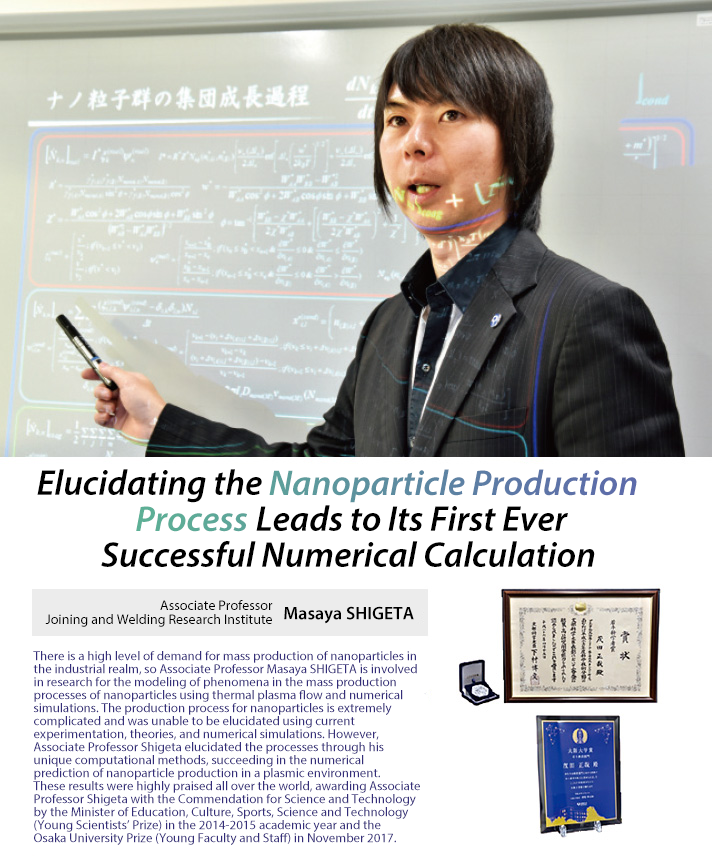
Elucidating the Nanoparticle Production Process Leads to its First Ever Successful Numerical Calculation
Developing formulas and algorithms to express and calculate phenomena in heat, matter, and flow
Nanoparticles are new materials that can be applied to various fields in environmental science, medicine, and engineering, such as in solar panels and drug delivery (systems for transporting necessary drugs to appropriate parts of the body). Mass production of nanoparticles is quite difficult, but it can be achieved by using the “thermal plasma,” a powerful light source.
“Thermal plasma is an extremely high temperature fluid.
So, metal powder materials injected into a
ball-shaped thermal plasma by applying a magnetic field evaporate instantly.
Thus, by cooling and condensing the vapor generated, one can produce metallic fog of 1 ~ 100 trillion per cubic centimeter, or metal nanoparticles, in abundance. But the reality is that there is great variability in the size and composition of nanoparticles.”
This
is because mechanisms for
nanoparticle production in thermal plasma are extremely complicated. In
addition, the temperature of thermal plasma exceeds 10,000
°
C, so direct
measurement through experimentation is difficult.
Thus, Associate Professor Shigeta grappled with theoretical clarification of the nanoparticle production process through the use of mathematical and physical measures.
He expressed phenomena of thermal hydraulics
and particle production
in
formula to create his own computational algorithm, succeeding in the world’s first numerical prediction of
mass production of intermetallic nanoparticle compounds.
In addition, “we also discovered the existence of
extremely complicated
vortex
flows and reverse flows
in plasma through numerical
simulations.” The existence of these
types of vortexes had already been suggested
, but it was
difficult to represent such peculiar phenomena in formulas and develop
algorithms to calculate these formulas. Through the mathematical model and
numerical simulation developed by Assoc. Prof. Shigeta, the details behind
thermal plasma flow were elucidated for the first time in the world.

Tackling plasma prediction for manufacturing high quality nanoparticles
The
reproduction of these unexplained phenomena
drove the
prediction of the
mass production process for producing high-quality nanoparticles in thermal plasma
has greatly advanced forward. “Fluids such as plasma tend to
generate
vortexes, but if the vortex
flow is too
strong, plasma cannot be controlled. If vortexes in plasma can be weakened, it may be possible to produce homogenized nanoparticles in
abundance.”
However, the behavior of thermal plasma has not been perfectly simulated, so Assoc. Prof. Shigeta has constructed a virtual experimental device in his computer and continued to search for a solution through trial and error.

His interest in things that flow -- pursuing mysteries with the edge of his mathematical approach
The best part of research on this subject is "mysteries cannot be elucidated through a single academic approach.
One can get to the bottom of things at last through multiple approaches in physics." Assoc. Prof. Shigeta also has a strong
interest in applied mathematics, saying, “Being able to take a mathematical
approach that I used
to get these research results is a personal strength of mine.”
He has been interested in flowing objects since he was young. “I think cream swirling in coffee and the smoke making elusive shapes full of twists and turns are natural art designs. I take joy in seeing flows, learning about flows, and recreating flows using my own theories and methods.”
He occasionally plays drums as a hobby with his bandmates. He’s so talented that a record label approached him as to his interest in having a record out. His favorite genre is rock, but, he laughed, “People have told me that it's hard to tell just by looking at me."

• Masaya SHIGETA

Associate Professor Shigeta received his doctorate in Engineering from the Graduate School of Engineering, Tohoku University, in 2004. After serving as a post-doc researcher at Tokyo Institute of Technology and the University of Minnesota, he started work as an assistant professor at the Graduate School of Engineering, Tohoku University. While there, he served as a visiting professor at the University of Bologna in 2010 and as a visiting researcher at UC Berkeley in 2012. He took his current position as an Associate Professor, Joining and Welding Research Institute, Osaka University in 2013.

Note: This is a reprint of the article posted in the Osaka University NewsLetter No. 78 (February 2018).